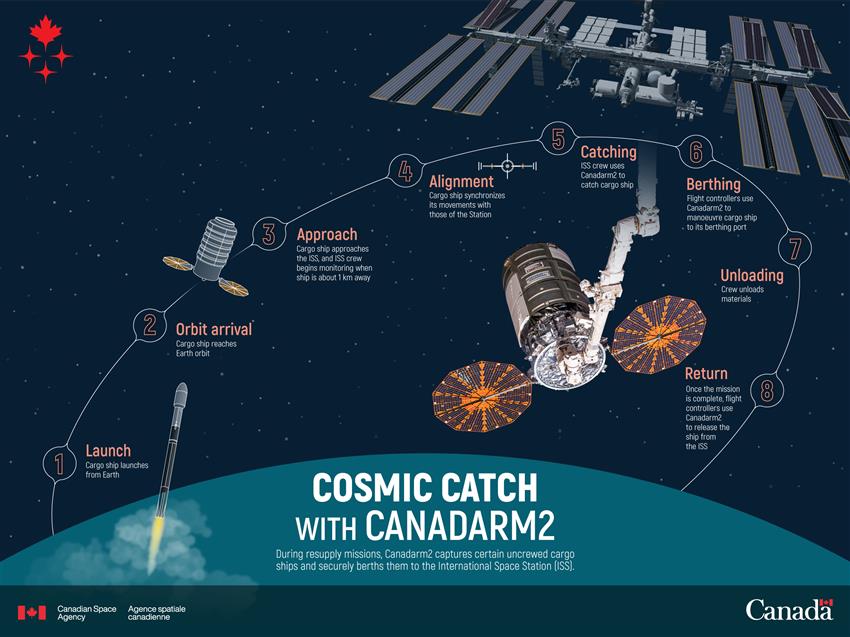Canadarm2's cosmic catches
Canada's contribution to the International Space Station (ISS) includes Canadarm2, the robotic arm that helped build the orbiting laboratory. The versatile Canadian invention is now used for regular maintenance tasks, and also lends a helping hand to "catch" unpiloted cargo ships.
Uncrewed ships are launched from Earth to bring supplies to the Station. These ships contain cargo, or payloads, such as:
- food
- spare parts
- scientific experiments
As a ship approaches the ISS, astronauts on board use Canadarm2 to reach out and grapple it – this tricky manoeuvre is known as a cosmic catch. Then, flight controllers berth the vehicle to the Station.
Cargo vehicles
Uncrewed cargo vehicles bring thousands of kilograms of cargo to the Space Station. Northrop Grumman's Cygnus is caught by Canadarm2 while SpaceX's Dragon, the only resupply spacecraft able to return cargo to Earth, docks autonomously to the Station.
Animation of Canadarm2 catching and berthing Northrop Grumman's Cygnus. (Credit: Canadian Space Agency)
How a cosmic catch works
Catching an uncrewed cargo ship calls for extremely precise work from Canadarm2:
Approach
With the help of GPS technology and a laser navigation system, the cargo ship slowly approaches the Station. Once the ship is approximately 1 km below them, the Space Station crew begins to monitor its progress to ensure a safe approach. The visiting ship then moves closer by occasionally firing its thrusters.
Alignment
The guidance and control system synchronizes the vehicle's movements with those of the Station. The two spacecraft fly in formation at an altitude of approximately 400 km above Earth and a speed of about 28,000 km/h.
Catching and berthing
An astronaut on board the ISS extends Canadarm2 and catches the ship. Once it has been caught, the team of flight controllers uses Canadarm2 to berth the vehicle to one of the Station's ports.
Unloading
The astronauts then open the airlocks between the Station and the ship and unload the contents. Dextre can also help unload bigger, bulkier items from the "trunk" of some of these vehicles. Cargo ships can remain docked to the ISS for up to a month.
Return
Once the mission is complete, the vehicle is released from the Station.

Text version of infographic about the cosmic catch of an uncrewed cargo ship by Canadarm2
Infographic about the cosmic catch of an uncrewed cargo ship by Canadarm2.
